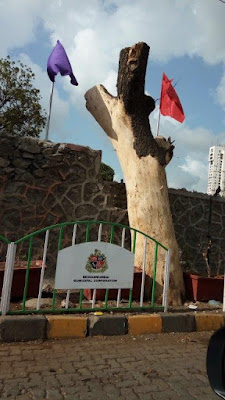Thane and its surroundings have been bestowed with nature’s bounty which is now under threat.
Thane and the newly formed Palghar district have large tracts of mangrove forests, fresh water bodies (lakes and ponds), estuaries, the forests of Sanjay Gandhi National Park (SGNP) and Tungareshwar. The magnificient Western ghats are also in close proximity and easily accessible. It is from these forests and the western ghats that we draw our sustenance in the form of annual monsoon rains.
There are two rivers flowing through Thane district, Vaitarna and Ulhas. The river Vaitarna originates in the hills of Tryambakeshwar as does river Godavari. However, Vaitarna covers a distance of about 150 kms only, compared to the mighty Godavari which flows over 1400 kms and finally flows into the Bay of Bengal. Vaitarna has several tributaries, some of them are Pinjal & Tansa. Ulhas river has its origins in Tungarli (near Lonavala) and its tributaries include Bhatsa and Barvi rivers.
The thick forests in the western ghats form a watershed ensuring an almost perennial source of water for states of Maharashtra, Karnataka and Andhra Pradesh with major rivers like Godavari, Krishna and Cauvery originating in these ghats.
The thick forests in the western ghats form a watershed ensuring an almost perennial source of water for states of Maharashtra, Karnataka and Andhra Pradesh with major rivers like Godavari, Krishna and Cauvery originating in these ghats.
Last undisturbed areas
These forests, rivers and wetlands are under pressure of the exploding human population and illegal occupation by land sharks. Compounding the problem is a reduction in diversity of forests with clearing of forests for agriculture, overgrazing by livestock, tree felling, pollution from industries and human settlements, and poaching of threatened bird and mammal species.
There are only a few areas present in the five coastal districts (Thane, Greater Bombay, Raigad, Ratnagiri and Sindhudurg) of Konkan Region that are undisturbed from human activities. With the present government’s emphasis on infrastructure development without adequate compensatory afforestation, there is clear and present danger to the very existence of the western ghats.
Some of the infrastructure projects affecting the environment are Mumbai Trans Harbour Link (MTHL): will flamingo habitat; the Mumbai-Nagpur Super expressway: will lead to land scale destruction of forest land; the Navi Mumbai airport and Goa highway expansion through Karnala bird sanctuary: can adversely affect migratory & endemic species; the metro III depot in Aarey colony: this would be the death knell for green cover in Mumbai.
Of course these projects are required to make commuting easier for all of us. But we can only hope that they do not tilt the delicate ecological balance against humankind.
Of course these projects are required to make commuting easier for all of us. But we can only hope that they do not tilt the delicate ecological balance against humankind.
Bird watching
Pictures from visit to Narsapur (off Kalyan Murbad highway)
Tributary of river Ulhas.White Wagtail
It is easily recognizable due its characteristic black and white plumage.
It has a typical habit of bobbing its tail, hence the name ‘wagtail’.
It is more common than the yellow wagtail.
The Large Pied Wagtail
It is much larger that the smaller White Wagtail.
Commonly seen near water bodies and grassy patches in gardens adjoining rivers and streams foraging for insects and worms.
Also spotted Tickell's Blue Flycatcher.









